As the Lancang-Mekong Cooperation (LMC) marks its eighth anniversary, China and ASEAN are accelerating high-quality regional trade development through river basin collaboration. In 2023, China-ASEAN trade reached 6.41 trillion yuan ($882 billion), with the six LMC countries (China, Cambodia, Laos, Myanmar, Thailand and Vietnam) contributing over 2.2 trillion yuan, accounting for 34.3 percent. As a "pioneering demonstration zone" for China-ASEAN cooperation, the LMC has injected strong momentum into high-quality regional economic and trade development through institutional innovation, industrial synergy, and rule alignment, becoming a benchmark under the Regional Comprehensive Economic Partnership (RCEP).

Youth representatives attending the 15th China-ASEAN Youth Campus take a photo with local students in Liuzhou, south China's Guangxi Zhuang Autonomous Region, August 15, 2024. /CFP
Institutional innovation: crafting an efficient "LMC model" for trade
The LMC's pioneering "tailor-made" approach addresses subregional development imbalances. The "3+5+X cooperation framework" established by the six countries, focusing on connectivity, industrial capacity and cross-border economy, has driven the implementation of projects worth $78 billion, including over 20 "trade arteries" such as the China-Laos Railway and the Phnom Penh-Sihanoukville Expressway. In 2023, international freight volume on the China-Laos Railway surged by 210 percent, boosting Laos' exports to China by 48 percent and transforming the landlocked nation into a "land-linked + sea-linked" economy.
Trade facilitation continues to improve. LMC countries pioneered a "single window" interoperability system, with China-Vietnam and China-Laos border ports adopting a "joint inspection" model that cuts customs clearance times by over 30 percent. In 2023, RMB settlement accounted for 76 percent of China-Myanmar border trade, while the China-Thailand "green channel" for agricultural products reduced fresh goods clearance to just six hours, showcasing the efficiency of regional "soft connectivity."
Industrial synergy: building a resilient supply chain "community"
Agricultural cooperation strengthens food security. China and Mekong countries have established 15 cross-border agricultural demonstration zones, promoting hybrid rice and other technologies to increase grain output by 3 million tons. In 2023, Thailand's durian, Cambodia's rice and Vietnam's coffee exports to China grew by 68 percent, 42 percent, and 35 percent, respectively, while Chinese agricultural machinery and smart irrigation equipment captured over 60 percent of the regional market, forming a modern agrarian supply chain based on "complementary advantages and shared risks."
Manufacturing upgrades reshape value chains. The China-Cambodia "Fish and Rice Corridor" and China-Myanmar Economic Corridor are attracting new industries like photovoltaic modules and new energy vehicles. In 2023, Chinese manufacturing investment in the LMC region hit $8.2 billion, up 31 percent year-on-year. Platforms like Vietnam's Haiphong Industrial Park and Thailand's Eastern Economic Corridor have raised regional trade in intermediate goods to 65 percent, accelerating integration into global high-end manufacturing chains.
Digital trade unlocks new growth. The LMC Cross-Border E-Commerce Platform, launched three years ago, has fostered innovative models like China-Thailand "livestreaming e-commerce + bonded warehouses" and China-Vietnam "digital border trade," driving regional e-commerce transactions to $58 billion in 2023. The Lancang-Mekong Cloud Computing Center, jointly built by China, Laos, and Thailand, supports a 25 percent annual growth rate in digital service trade.
Rule alignment: leading a high-standard trade system
As an RCEP "testing ground," LMC countries have harmonized rules of origin. In 2023, they issued 120,000 RCEP preferential origin certificates, covering goods worth over $40 billion. The China-Cambodia FTA and China-Laos Five-Year Economic Plan expanded tariff reductions to 95 percent of goods and mutual recognition standards across eight categories, including agriculture and electronics.
Green trade rules take the lead. The Lancang-Mekong Environmental Cooperation Center established a "carbon footprint mutual recognition mechanism," with low-carbon product trade exceeding $30 billion in 2023. Pilot projects like the China-Laos Railway's "carbon-neutral" freight service and China-Thailand's "zero-carbon industrial parks" provide practical pathways for regional carbon market development.
Looking ahead: leveraging river basin cooperation to elevate China-ASEAN trade
The LMC is transitioning from "project-driven" to "institution-driven" cooperation:
1. Advance the Lancang-Mekong Economic Development Belt Plan, including the China-Laos-Thailand-Malaysia Railway and Trans-Asian Railway, to create a "trade artery" across the Indo-China Peninsula.
2. Deepen cross-border industrial chains, building 10 regional clusters in new energy, biopharma and AI.
3. Innovate digital governance rules, establish a Lancang-Mekong Digital Free Trade Zone and pilot cross-border digital currency settlements.
4. Strengthen green standards, create a regional green product certification system and expand carbon market cooperation.
Eight years of LMC practice prove that small multilateral mechanisms based on river basins can effectively address fragmented regional development. As China-ASEAN FTA 3.0 negotiations accelerate, the LMC's institutional innovations, industrial synergy and people-to-people bonds will offer a replicable "China solution" for broader, high-quality economic and trade development. This mighty international river is witnessing a new chapter in China and ASEAN's shared trade upgrade.
(The writer is Wang Jingyu, an associate researcher at the Institute of Ecological Civilization of Zhejiang A&F University, and Wang Fengting, an associate researcher at the same institute.)


